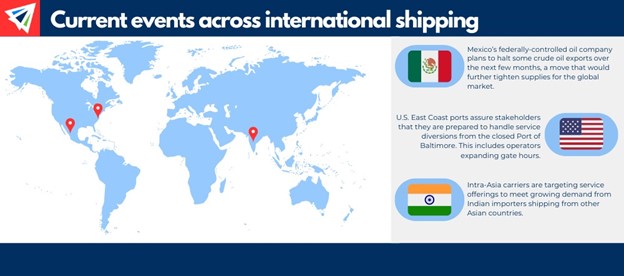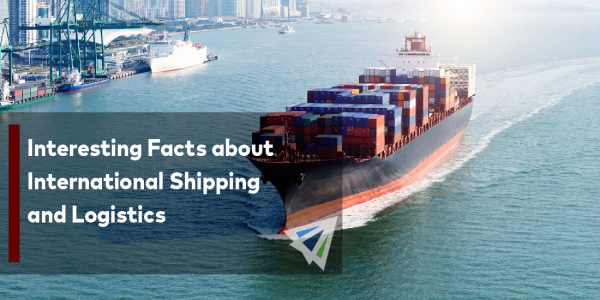Competitive Edge
April 3rd, 2024
Stay Current with InterlogUSA
Latest Industry Happenings and Market Updates:

IMPORT: Asia to North America (TPEB)
Recent Developments:
- General rate increases (GRIs) were not implemented at the start of April.
Rates: The downward trend on rates continues to hold.
Space: Space is mostly open but has tightened in pockets.
Capacity: According to the Journal of Commerce ocean carriers are reducing their instances of blank sailings and increasing capacity in this market. The change in strategy suggests that continued longer voyages around Africa are requiring more vessel allocation than when the diversions began in December.
Equipment: Investments from independent equipment providers (IEPs) mirror expectations of an upswing in freight activity.
TIPS:
- Hold your logistics partners accountable for frequent updates regarding current market conditions and routing impacts.
- Be flexible and adaptive to alternative service options, especially as it relates to potential savings on cost or transit.
IMPORT: Europe to North America (TAWB)
Rates: Rates have decreased slightly.
Space: Space is open.
Capacity: This trade’s capacity glut has shown signs of improvement. There is lesser imbalance between capacity and demand.
TIPS:
- Book at least three weeks prior to the ready date.
- Familiarize yourself with the European Union’s ETS program and how its carbon taxing is impacting operating costs for ocean carriers.
EXPORT: North America to Asia
Rates: Rates have climbed after falling throughout March.
Capacity: Space remains open, particularly from West Coast ports.
Equipment: Export containers are being diverted to other East Coast ports of loading following the Port of Baltimore’s indefinite suspension to ship traffic.
TIPS:
- Insufficient communication with sailing schedules can lead to higher detention and demurrage fees as well as higher trucking and storage costs. Ensure your logistics partners are not keeping you and your cargo in the dark.
Freight News
Transport Workers in Finland Extend Strike
Finland’s trade unions announced that they are extending the strike to April 8th. It was originally scheduled to end on Monday, April 1st. The unions say it will continue until its demands were met.
Cargo operations at Finland’s ports, as well as the railroads, continue to be mostly stopped. Unions say they are willing to pause the strike when the government “shows understanding for the workers’ concerns.”
Those involved in these actions are the Automotive and Transport Workers’ Union (AKT), the Service Trade Union (PAM), the Construction Union, the Public and Welfare Union (JHL), and the Electricity Union.
Labor reform is one of the key issues in this strike, as Finland’s government announced plans to favor local work agreements over centralized bargains, limit political strikes, cut social welfare and make it easier to terminate contracts, Reuters reports.
The Confederation of Finnish Industries (EK), who represents the employers, told factory workers a week into the strike that their wages could be suspended as a result of the strike action’s knock-on impacts and factory closures, the Maritime-Executive reports.
The Baltimore Bridge Collapse, East Coast Ports Extending Hours
On March 26th, around 1:30am, the Dali cargo ship hit Baltimore’s Francis Scott Bridge. Since this incident, the Port of Baltimore has closed inbound and outbound vessel traffic, but truck operations at terminals inside the port would continue. As of now, it is unclear when the port will reopen.
In response to the Port of Baltimore being closed for the time being, port operators on the East Coast say they are prepared to handle container ships that divert from Baltimore.
Furthermore, per the JOC, marine terminals in New Jersey and Virginia are expanding their gate hours.
As of April 1st, Port Newark Container Terminal says they will keep their truck gates open until 6pm, instead of their usual 4pm closure. Starting April 6th, PNCT says they will be open Saturdays from 7am to 3pm for an undefined time. The Port of Virginia is extending their gate hours as well, opening at 5am instead of their usual 6am.
Additionally in the future once the debris from the incident is removed, the U.S. Army Corps of Engineers will need to examine and determine if there was damage to the ship channel, which is 50 feet deep and 800 feet wide.
Watch Our March Webinar
Sign Up For Our April Webinar
Our next webinar is Wednesday, April 17th, at 10am CDT!
Topics will be announced soon. Register Today!
Note: After you register, if you do not see your webinar invite to make sure you check your junk/spam email for the webinar invite. Reach out if you have any questions at support@interlogusa.com)
If you have any topic suggestions or questions for our experts..
please reach out to us at support@interlogusa.com
Interlog  Insights
Insights
Last week we recapped our March Insights. This Friday we will be releasing our week one April insights.
Our subscribers (it’s free to sign-up) are able to see our weekly insights every month in real time when they get sent out every Friday at 10am CST.
Sign up for our
industry answers
Our team works to provide valuable, unique, and relevant content to assist you in finding solutions. Sign up now.

